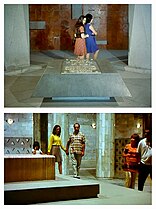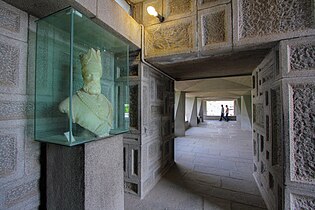Tomb of Nader Shah
| Tomb of Nader Shah | |
|---|---|
آرامگاه نادرشاه | |
 | |
 | |
| General information | |
| Architectural style | Iranian architecture |
| Town or city | Mashhad |
| Country |  Iran Iran |
| Completed | 1963 |
| Design and construction | |
| Architect(s) | Hooshang Seyhoun |
Tomb of Nader Shah (Persian: آرامگاه نادرشاه) is a building in Mashhad designed by Hooshang Seyhoun.[1][2][3][4]
About the person
Nader Shah was born into an ordinary family from the Qirqlu branch of the Afshars, a Turkic tribe living in Khorasan. When Safavid Iran was invaded by the Afghans, he entered the service of Safavid shah Tahmasp II and was named Tahmasp Qoli Khan. As a result of his skillful activity, he defeated the Afghans, the Ottomans, and the Russians in a short period of time and expelled all the Safavids from the land. During this process, he strengthened his position, dethroned Tahmasp II in 1732, and proclaimed his young son Abbas III as king. In 1736, calling a congress in Mughan, dethroning Abbas III, and declaring himself shah, he ended the 235-year rule of the Safavid dynasty.
History
After Nader's successful campaign against the Mughal Empire, he returned to his homeland with immense wealth: the peacock throne, the Koh-i-Noor diamond, and “700 elephants, 4,000 camels and 12,000 horses carrying wagons all laden with gold, silver and precious stones”. After the precious jewels brought from India were hidden near Kalat, Nadir ordered the Mughal architects he had brought with him to build a magnificent mausoleum for him. This mausoleum must have been in the Mughal style.[5]
As a result of Nader Shah's assassination in 1747, the mausoleum was not completed during his lifetime. In this period, another example of architecture built in the Mughal style by Nadir Shah in the city of Mashhad was called "Sun Palace" or Kakh-e Khurshid. This mausoleum was converted into a residence palace by various tribal leaders and Nader Shah’s body remained un-commemorated until the 1960s when a concrete monument was constructed for him in the vicinity of a heavily polluted traffic intersection in Mashhad.[6]
Interior
Despite its incomplete exterior, the interior of the Khorshid is fully refined: each doorway is decorated by miniature paintings and Mughal frescoes.[7]
Gallery
-
 Tombstone of Nader and Ferdowsi, at the Mashhad 1970s
Tombstone of Nader and Ferdowsi, at the Mashhad 1970s -

-

-

-

-

-

-
-
 The statue of Nadir Shah kept in the mausoleum
The statue of Nadir Shah kept in the mausoleum
Sources
- ^ "Tomb of Nader Shah". Visit Nader Shah’s mausoleum in Mashhad. Retrieved 7 July 2019.
- ^ "Tomb of Nader Shah". www.itto.org. Retrieved 31 July 2019.
- ^ "Tomb of Nader Shah in Mashhad". www.alaedin.travel/en. Retrieved 31 July 2019.
- ^ "Encyclopaedia of the Iranian Architectural History". Cultural Heritage, Handicrafts and Tourism Organization of Iran. 19 May 2011. Archived from the original on 6 April 2015.
- ^ "كاخ خورشيد، نگين درخشان معماري خطه كلات". ایرنا (in Persian). 2016-03-02. Archived from the original on 2021-11-26. Retrieved 2021-11-26.
- ^ Dalrymple, Sam. "Here lay Nader Shah". Conde Nast Traveller.
- ^ Dalrymple, Sam. "Here lay Nader Shah". Conde Nast Traveller.
- v
- t
- e
- Mausoleum of Attar of Nishapur
- Avicenna Mausoleum
- Baba Tahir Mausoleum, Hamadan
- Baba Tahir Mausoleum, Khorramabad
- Besh Qardash
- Chehel Dokhtaran mausoleum
- Fakhrigah
- Grave of Pir Quzhd
- Gur-e-Dokhtar
- Imamzadeh Hamzeh, Kashmar
- Khaje Taj od-Din mausoleum
- Kharraqan towers
- Mausoleum of Reza Shah
- Mausoleum of Ruhollah Khomeini
- Mausoleum of Mir Bozorg
- Mausoleum of Shah Abbas I
- Mausoleum of Omar Khayyám
- On ibn Ali's shrine
- Pir Bakran mausoleum
- Qadamgah Hazrat Ali
- Shah Cheragh
- Sheikh Ahmad-e Jami mausoleum complex
- Sheikh Safi al-Din Khānegāh and Shrine Ensemble
- Shrine of Abu Lu'lu'a
- Tomb of Sheikh Yusof Sarvestani
- Tomb of Abu al-Hassan Kharaqani
- Tomb of Abu Usman Al-Maghribi
- Tomb of Ahmad ibn Ishaq
- Tomb of Ali ibn Hamzah, Shiraz
- Tomb of Artaxerxes I of Persia
- Tomb of Baba Loghman
- Tomb of Bibi Dokhtaran
- Tomb of Boghrat
- Tomb of Cyrus
- Tomb of Daniel
- Tomb of Darius II
- Tomb of Esther and Mordechai
- Tomb of Ferdowsi
- Tomb of Hadi Sabzevari
- Tomb of Hassan Modarres
- Tomb of Haydar Amuli
- Tomb of Heydar Yaghma
- Tomb of Kamal-ol-molk
- Tomb of Khajeh Rabie
- Tomb of Mir Zobeyr
- Tomb of Nader Shah
- Tomb of Pir Palandouz
- Tomb of Rais al-Mojahedin
- Tomb of Shah Firooz
- Tomb of Shah Qalandar
- Tomb of Seyed Alaeddin Husayn
- Tomb of Shaykh Haydar
- Tomb of Sheikh Shahab ol-Din Ahari
- Tomb of Wais
- Tomb of Xerxes I
- Tomb of Ya'qub ibn al-Layth al-Saffar























